#Echis carinatus
Text
En Ölümcül 10 Yılan Türü
En Ölümcül 10 Yılan Türü
En Ölümcül 10 Yılan Türü
Bu sürüngenlerden biriyle karşılaşmanız hayatınıza mal olabilir. Tıslıyorlar, sürünüyorlar ve ne yazık ki şüphelenmedikleri avları ve insanları ısırıyorlar. Dünya Sağlık Örgütü’ne göre, yılanlar her yıl yaklaşık 5,4 milyon insanı ısırarak 81.000 ila 138.000 arasında ölüme neden oluyor.
Zehirli yılanlar, kurbanlarını, dişlerini kullanarak avına enjekte ettiği değiştirilmiş…

View On WordPress
#Bantlı Krait#Bothrops asper#Bungarus fasciatus#Daboia russelii#Dendroaspis polylepis#Dispholidus typus#Echis carinatus#En Ölümcül 10 Yılan#En Ölümcül 10 Yılan Türü#Fer-de-lance#Güney Afrika Yeşil Ağaç Yılanı#İnland Taypan#kara mamba#Kıyı Taypanı#Kral Kobra#Ophiophagus hannah#Oxyranus scutellatus#Oxyuranus microlepidotus#Russel Engerek#Testere Pullu Engerek#tür#yılan#zehir
0 notes
Text
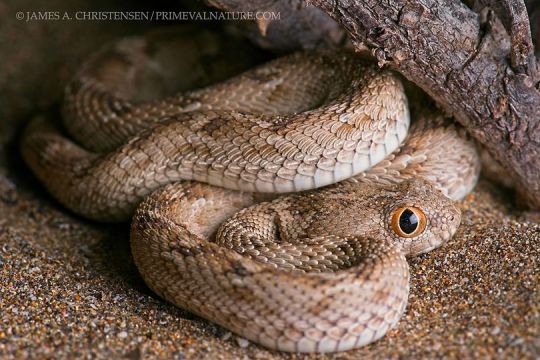
Sindh Saw-scaled Viper (Echis carinatus sochureki), juvenile, family Viperidae, Al Batinah South Governorate, Oman
Saw-scaled vipers are regarded by some as “the most dangerous snake in the world”. They are responsible for more deadly snake bites than any other species.
Though they are not the most potently venomous snake in the world, they do have very potent venom.
They have a huge geographic range, across northern Africa, the Middle East, and the Indian subcontinent.
They are rather aggressive (in defense), and will strike multiple times.
There are 5 subspecies.
photograph by James Christensen
272 notes
·
View notes
Text
Title: The Six Deadliest Snake Bites: Unveiling Nature's Venomous Threats
Introduction:
Snakes, both fascinating and fearsome creatures, have evolved venomous adaptations to aid in hunting and self-defense. While most snake species are harmless, some possess venom that can be lethal to humans. In this article, we explore the six deadliest snake bites, shedding light on the potent venoms that have earned these serpents a reputation as nature's silent killers.
1. Inland Taipan (Oxyuranus microlepidotus):
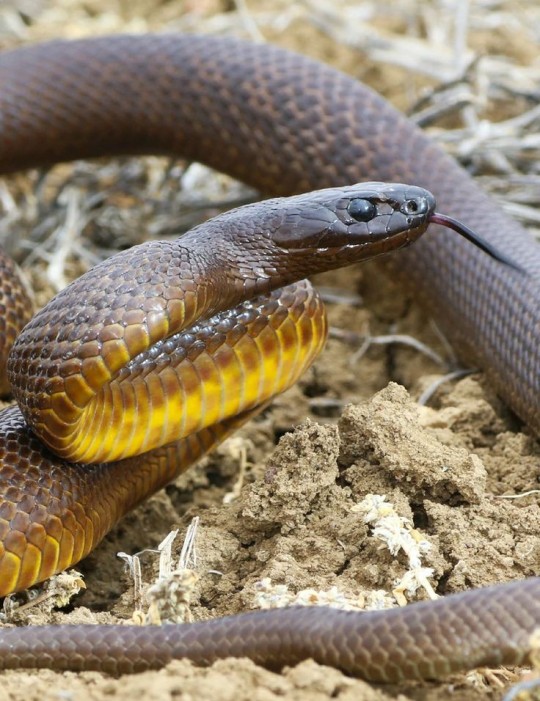
Dubbed the "fierce snake," the Inland Taipan hails from Australia and boasts the most toxic venom of any snake. Its venom is a complex cocktail of neurotoxins, causing paralysis and potentially leading to death within hours if left untreated. Fortunately, human encounters with this reclusive snake are rare, and antivenom exists to counter its potent bite.
2. Coastal Taipan (Oxyuranus scutellatus):
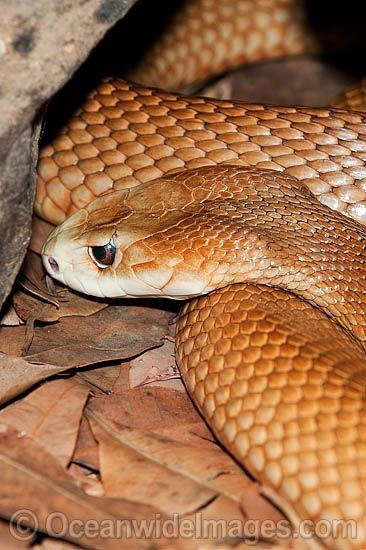
Another Australian native, the Coastal Taipan, possesses venom containing both neurotoxins and coagulants. A bite can result in rapid paralysis, respiratory failure, and internal bleeding. Swift medical intervention and the availability of antivenom are crucial to increasing chances of survival.
3. Black Mamba (Dendroaspis polylepis):

Found in Africa, the Black Mamba is known for its incredible speed and highly potent venom. Its neurotoxic venom can cause paralysis and severe tissue damage. Bites often result in rapid onset of symptoms, making immediate medical attention essential for survival.
4. Russell's Viper (Daboia russelii):

Widespread in Asia, Russell's Viper delivers a venom rich in toxins that affect blood clotting. A bite can lead to uncontrollable bleeding, organ damage, and shock. This snake is responsible for many snakebite-related deaths in its range.
5. Saw-scaled Viper (Echis carinatus):

This small but deadly snake inhabits parts of Africa, the Middle East, and South Asia. Its venom contains a mix of toxins that lead to pain, swelling, and severe bleeding. Due to its cryptic nature and habitats near human settlements, encounters are common, resulting in a high number of fatalities.
6. King Cobra (Ophiophagus hannah):
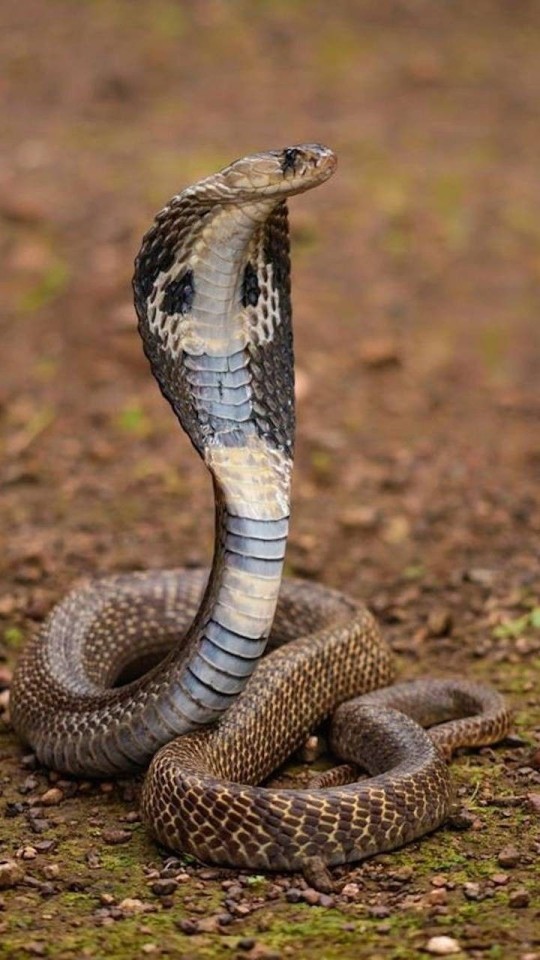
Known as the world's longest venomous snake, the King Cobra's bite delivers a potent neurotoxic venom. While it's not as venomous as some other species on this list, the large quantity of venom it can inject makes it extremely dangerous. Bites can lead to paralysis and death within hours if untreated.
Conclusion:
The world of venomous snakes is a testament to the diverse and intricate mechanisms of nature's deadliest hunters. While the mere mention of these snake species may evoke fear, it's important to remember that snakebite incidents are relatively rare, and antivenom treatments have saved countless lives. Awareness, education, and appropriate precautions when in snake-prone areas are key to mitigating the risks associated with these fascinating yet dangerous creatures.
#Snake#venom snake#health#deadliest snake#foryou#1950s#80s#barbie#bmw#cars#cute#drawing#ferrari#rwby#succession
2 notes
·
View notes
Text
Enhanced Catalytic Destruction of Acid solution Red Several Absorb dyes by simply Peroxymonosulfate on Co3O4 Advertised simply by Bi2O3.
The volume of components might foresee the actual level associated with heart atherosclerosis throughout people with out recorded CAD.Not like Naja naja, Bungarus caeruleus, Echis carinatus, and Daboia/Vipera russellii venoms, Ophiophagus hannah venom will be medically disregarded within the Indian subcontinent. Is the biggest poisonous reptile, E. hannah continues to be believed to be able to put in many deadly doasage amounts involving venom in one chunk. Deficiency of therapeutic antivenom to O. hannah bite inside Indian makes virtually any try and save the particular target a hard exercising. This study was started that compares O. hannah venom with all the previously mentioned mentioned venoms pertaining to probable interference within hemostasis. Ophiophagus hannah venom was found to actively get in the way within hemostatic stages like fibrin clog development, platelet activation/aggregation, and also fibrin blood clot dissolution. It reduced partial thromboplastin moment (aPTT), prothrombin time (PT), as well as find more thrombin clots time (TCT). These kind of activities are similar to that will revealed by simply Electronic. carinatus along with N. russellii venoms, and thus O. hannah venom was discovered for you to apply procoagulant task with the common walkway regarding bloodstream coagulation, even though D. naja venom increased aPTT and also TCT although not PT, so because of this it had been discovered to be able to put in anticoagulant action through the inbuilt walkway. Venoms regarding E. hannah, At the. carinatus, and Deb. russellii shortage plasminogen activation property since they don't hydrolyze azocasein, when they most demonstrate plasmin-like activity by simply degrading your fibrin blood clot. Although D. naja venom didn't decay azocasein, in contrast to other venoms, it revealed puny plasmin-like activity about fibrin clog. Venom regarding Elizabeth. carinatus brought on clots associated with human platelet abundant plasma televisions (PRP), while the some other about three venoms interfered inside agonist-induced platelet place within PRP. Venom involving A. hannah minimum limited the actual ADP induced platelet aggregation as compared with Deb. russellii as well as N. naja venoms. Each one of these three venoms confirmed comprehensive hang-up associated with epinephrine-induced gathering or amassing from various doasage amounts. However, To. hannah venom was distinctive within curbing thrombin brought on gathering or amassing.The ovulatory gonadotropin rise handles appearance regarding plasminogen activator (Missouri) members of the family within the ovarian follicle, which can be suggested as a factor throughout hair follicle wall deterioration at ovulation. Gonadotropin additionally encourages follicular prostaglandin E2 (PGE2) manufacturing, that's needed for follicles crack. To ascertain whether or not the ovulatory gonadotropin rise handles PA-mediated proteolysis by means of PGE2 from the primate hair follicle, monkeys received gonadotropins to be able to encourage follicles growth. Follicular aspirates or perhaps entire ovaries had been received ahead of (3 they would) after man chorionic gonadotropin (hcg diet) supervision to course your periovulatory period. Granulosa mobile or portable levels of tissue-type Missouri (tPA) and pop chemical sort 1 (PAI-1) proteins have been minimal at 0 hcg weight loss and higher soon after hCG supervision. Within situ zymography demonstrated no ovarian tPA task 0 following hcg weight loss; tPA exercise had been within granulosa cellular material obtained after hCG treatment method. Notably, tPA along with PAI-1 proteins and also tPA activity ended up low/nondetectable in granulosa cells obtained following treatment along with hCG and also the PG combination chemical celecoxib. To find out no matter whether hCG stimulation associated with tPA along with PAI-1 needs PGE2, granulosa tissues attained with 3 h have been classy along with hcg weight loss plus indomethacin to be able to slow down PG production; a number of tissues in addition gotten PGE2 or an agonist selective for one PGE2 receptor (Air). PGE2, an EP2 agonist, as well as an EP3 agonist increased tPA proteins, although PGE2, a great EP1 agonist, with an EP3 agonist greater PAI-1 health proteins.
0 notes
Link
#dangeroussnakeintheworld#deadliestsnakeintheworld#deadliestsnakes#inlandtaipanmostvenomoussnake#largestvenomoussnakes#largestvenomoussnakesintheworld#longestpoisonoussnake#longestvenomoussnake#mostdangeroussnake#mostdangeroussnakeintheworld#mostdeadliestsnakeintheworld#mostdeadlysnake#mostdeadlysnakeintheworld#mostpoisonoussnake#mostpoisonoussnakeintheworld#mosttoxicsnakeintheworld#mostvenomoussnake#mostvenomoussnakeintheworld#mostvenomoussnakeonearth#mostvenomoussnakesintheworldranked#mostvenomoussnakesintheworldranked2021#poisonoussnakesintheworld#sawscaledvipersnakes#sawscaledvipersnakescompleteinformationinalltopics#sawscaledvipersnakesinformation#sawscaledvipersnakesinformationinalltopics#smallestpoisonoussnakeintheworld#thelongestvenomoussnakeonplanet#themostpoisonoussnake#top1dangeroussnakeintheworld
0 notes
Text
This man gets bitten by deadly snakes in the name of science
New Post has been published on https://petnews2day.com/pet-news/small-pet-news/this-man-gets-bitten-by-deadly-snakes-in-the-name-of-science/
This man gets bitten by deadly snakes in the name of science
The World Health Organisation (WHO) estimates that 5.4 million people a year are bitten by snakes, and up to 2.7 million of them envenomed. Between 81,000 and 138,000 people die from the bites, while up to 400,000 have limbs amputated or suffer other permanent disabilities. The tropical and sub-tropical regions of Africa, Asia and Latin America are most affected. Most at risk of dying are agricultural workers and, because of their smaller body mass, young children. A lack of footwear makes poor rural workers particularly vulnerable.
(Read: In Africa, snake bites are a neglected health crisis.)
It’s possible many other victims go unreported. The Africa Health Organisation explains that this is “because victims seek treatment from non-medical sources or do not have access to health care”.
Deadly serpents by numbers
There are 600 or so species of venomous snakes slithering round the planet. But only around a dozen species groups are responsible for most human deaths and disabilities. As the WHO warns, some are found close to farmers who aren’t wearing adequate footwear. Others are more aggressive, or deliver venom more efficiently, or in amounts large enough to kill humans.
Bearing these factors in mind, statistically, among the deadliest of all are black mamba, coastal taipan, Indian cobra, common krait, Russel’s viper and saw-scaled viper. The latter – scientific name Echis carinatus – which lives across the Middle East and Central Asia, especially in the Indian subcontinent, is considered by many herpetologists the biggest human killer of all. Relatively small, usually no longer than 60cm, it is inconspicuous but extremely aggressive. It rests in a coil, with its head at the centre, so that when it strikes, it darts out like a released spring.
A 2020 university study found that, in India alone, 58,000 people die every year from snake bites, and in most cases the saw-scaled viper is the culprit. (Here’s why poisonous animals don’t poison themselves.)
One British herpetologist who knows all about this lethal creature is Professor Nicholas Casewell, director of the Centre for Snakebite Research and Interventions at the UK’s Liverpool School of Tropical Medicine. Originally set up in the early 1980s, the centre now houses 200 venomous snakes from around 50 different species, and is the largest herpetarium in the UK.
0 notes
Text
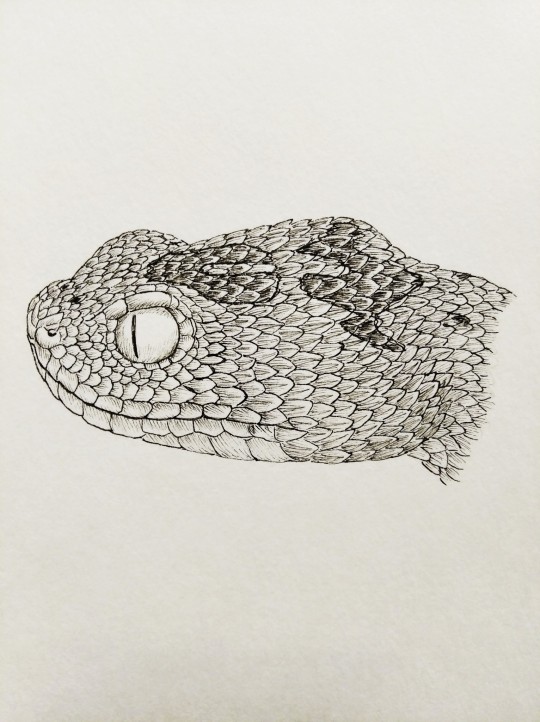
4 notes
·
View notes
Photo

Saw-Scaled Viper
Echis Carinatus
Souerce: Here
#snake#snakes#reptile#reptiles#animal#animals#pet#pets#nature#wildlife#cool#interesting#aesthetic#aesthetics#beautiful#pretty#snek#sneks#Echis carinatus#viper#vipers#saw-scaled viper#saw scaled viper
132 notes
·
View notes
Photo

Todays Snake Is:
The Saw-scaled Viper (Echis carinatus) is a venomous snake found in southern Asia and the Middle East. As much of its range is composed of desert, these snakes are one of the few adept at side-winding. Individuals will often congregate on bushes and scrub during rain to drink.
(x)
197 notes
·
View notes
Photo

Marvelous Poisons
#illustration#artists on tumblr#coffee#poison#poisons#opium#hemlock#mandrake#snake#echis#echis carinatus#gila monster#saw-scaled viper#venom#venomous snake#medicine#medicinal#saw scaled viper
122 notes
·
View notes
Note
And poof- a random halo naga(just thought halo would be a 'Echis carinatus')

I tried-
8 notes
·
View notes
Text
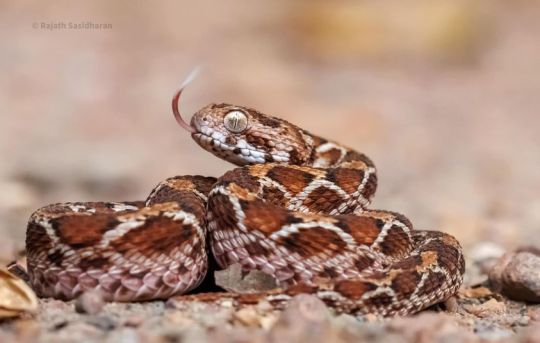
Saw-scaled Viper (Echis carinatus), family Viperidae, Kerala, India
Saw-scaled vipers are regarded by some as “the most dangerous snake in the world”. They are responsible for more deadly snake bites than any other species.
Though they are not the most potently venomous snake in the world, they do have very potent venom.
They have a huge geographic range, across northern Africa, the Middle East, and the Indian subcontinent.
They are rather aggressive (in defense), and will strike multiple times.
There are 5 subspecies.
photograph by Rajath Sasidharan
https://www.instagram.com/rajathsasidharan/
245 notes
·
View notes
Text
DustTale Papyrus Lamia
Name: Natus
Species: Echis carinatus
Size: 15 - 20 feet total, 4 - 6 feet standing(fullsize) 20 - 35 inches total, 8 - 12 inches standing (mini) 20 - 40 feet total, 10 - 12 feet tall(bara)
Venom: yes
Personality: Sassy, smug, mischievous, picky,
Likes: Soft things, annoying others, puzzles, cooking, being cared for,
Dislikes: Bad food, being excluded or ignored,
Compatibility: They love annoying others to the point of fights, but as they are weak they can exactly win any fights, but if you have a Dust sans(or DustSwap papyrus) type they often rely on them to fight for them,
They typically stay in one of their nests, and becuase of this they make a lot more nests then the average lamia and need a lot more things to make them,
They need a lot of attention and can get very hard to manage when ignored or excluded to much,
They love puzzles, any kind of puzzle, and its a great way to include them and to just entertain them,
Feeding habits: They can be extremely picky at times, its best to stick to pasta's for them, or letting them cook,
Additional info: They are somewhat fragile, and can get hurt very easy, its best to make sure that they are in a safe place before getting to far away from them,
Zone: N/A, Inside
In Universe: These bitties are seen as an annoyance and one not many care for,
Difficulty: Intermediate
Features:
Main colors: Tan, orange,
Secondary colors: Brown, red, orange,
Extra: Saw-Scales
Additional info: has a alternating circular pattern,

11 notes
·
View notes
Photo

“Is this snake highly venomous” and “is this snake dangerous” and “will this snake bite me” are very different questions.
And to be clear, I don’t want to do snakes dirty here! Snakes are fascinating and an important part of the environment. The vast majority, venomous or not, will only bite if they truly have no other choice. The high toll throughout the Indian subcontinent is largely an issue of rural medical access and anti-venom specificity and shelf-life.
Transcript below the cut.
How do we judge the most dangerous snake?
There are roughly 3,400 species of snakes on Earth. About 600 are venomous, but only a third are considered by the World Health Organization to be dangerous to humans.
Rankings of venomous snakes are usually made based on the median lethal dose, or LD50. This is the dose at which half of test mice will die. Stronger venoms have a lower LD50, indicating that a small dose can be fatal. As LD50 is given in milligrams of venom per kilogram of body weight, it can be scaled up to the weight of a human, resulting in claims that a single bite could kill many humans. However, these estimates are rough at best and assume the venom of a rodent-eating snake will affect humans as strongly as it affects its natural prey.
Furthermore, potency alone does not tell the whole story. The inland taipan (Oxyuranus microlepidotus) is the most venomous land snake but is extremely shy and would rather flee than confront a human—an encounter which rarely happens to begin with, as it lives in the remote Australian desert. The coastal taipan (Oxyuranus scutellatus) is slightly less venomous but will readily strike if confronted, and is often considered more dangerous than its cousin. Even so, bites are rare and there have been only a few fatalities since the development of an anti-venom.
So which species is responsible for the most human deaths? The award goes to not one, but the Big Four: the saw-scaled viper (Echis carinatus), Russel’s viper (Daboia russelii), Indian cobra (Naja naja), and common krait (Bungareus caeruleus). Together they are responsible for most of India’s 50,000 annual snakebite deaths. Their venoms aren’t as potent as other species, but they are common in poor, rural areas that have inadequate access to medical treatments.
#scientific illustration#snake#snakes#venom#reptile#viper#taipan#australia#india#biology#medical#sciart#herpetology#my art#artists on tumblr#original art
299 notes
·
View notes
Text
Saw-Scaled Viper (Echis carinatus)
Saw-Scaled Viper (Echis carinatus)
Saw-Scaled Viper (Echis carinatus) of Pakistan Saw-Scaled Vipers
Saw-scaled viper, (genus Echis), any of eight species of small venomous snakes (family Viperidae) that inhabit arid regions and dry savannas north of the Equator across Africa, Arabia, and southwestern Asia to India, Pakistan and Sri Lanka.
They are…
View On WordPress
#carinatus#echis#echis carinatus#forestry#forestrypedia#how saw scaled viper attacks#how viper snake attacks#is saw scaled viper dangerous#pedia#saw#saw scaled viper#saw scaled viper echis carinatus snakes in pakistan#saw scaled viper in pakistan#saw scaled viper most kills due to snake bite#saw scaled viper snakes found in pakistan#scaled#viper#viper snake#viper snake in desert#viper snake in india#viper snake in pakistan#where saw scaled viper is found
0 notes
Audio
(Tea Are Sea)
0 notes